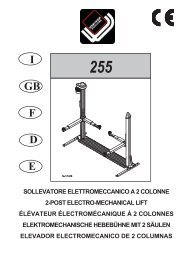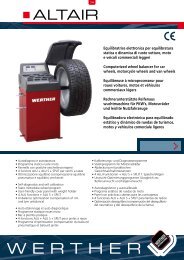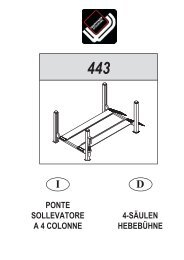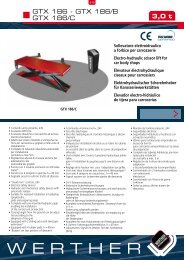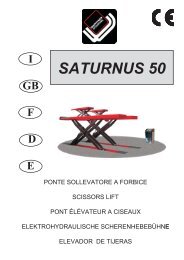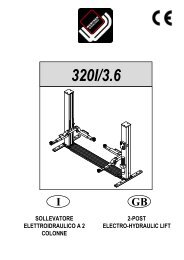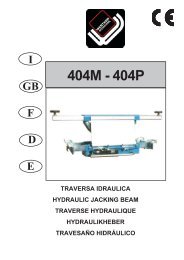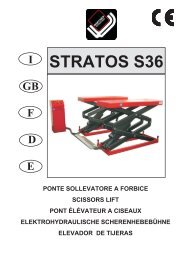253/3 - Wertherint.de
253/3 - Wertherint.de
253/3 - Wertherint.de
Create successful ePaper yourself
Turn your PDF publications into a flip-book with our unique Google optimized e-Paper software.
Fig.18 - Abb.18<br />
Fig.19 - Abb.19<br />
Fig.20 - Abb.20<br />
Fig.21 - Abb.21<br />
26<br />
RISCHI DIRETTI ALLE PERSONE<br />
In questo paragrafo verranno illustrati i rischi che operatore, manutentore<br />
e chi si trova nell’area di lavoro <strong>de</strong>l sollevatore, possono correre a<br />
causa di un uso non corretto <strong>de</strong>l sollevatore stesso.<br />
RISCHIO DI SCHIACCIAMENTO DELL’OPERATORE<br />
dovuto ad una errata posizione <strong>de</strong>ll’operatore ad<strong>de</strong>tto al quadro comandi.<br />
Durante la fase di discesa <strong>de</strong>lle pedane e <strong>de</strong>l veicolo l’operatore non<br />
<strong>de</strong>ve mai portarsi sotto le parti mobili in fase di discesa ma operare soltanto<br />
dalla zona comando (fig.18).<br />
RISCHIO DI SCHIACCIAMENTO DEL PERSONALE IN GENERE<br />
Durante la fase di discesa <strong>de</strong>l sollevatore e <strong>de</strong>l veicolo il personale non<br />
<strong>de</strong>ve sostare in zone interessate dalle traiettorie di discesa (fig.19). L’operatore<br />
<strong>de</strong>ve manovrare solo dopo essersi accertato che nessuna persona<br />
sia in posizioni pericolose.<br />
RISCHIO DI URTO<br />
Dovuto alle parti <strong>de</strong>l sollevatore o <strong>de</strong>l veicolo posizionate ad altezza<br />
d’uomo.<br />
Quando, per ragioni di lavoro, il sollevatore viene fermato a quote relativamente<br />
basse (inferiori a 1,75 m dal suolo) vi è il rischio di urtare contro<br />
le parti non evi<strong>de</strong>nziate da particolari colorazioni (Fig.20).<br />
RISCHIO DI SPOSTAMENTO DEL VEICOLO<br />
Dovuto ad operazioni da compiere e che generano spinte sul veicolo<br />
(fig.21).<br />
Se il veicolo é di dimensioni o pesi ragguar<strong>de</strong>voli uno spostamento può<br />
rappresentare una situazione di sovraccarico o sbilanciamento non previsto<br />
pertanto evitare in maniera assoluta tali manovre.<br />
RISKS TO PERSONS<br />
This paragraph illustrates risks to which the operator, maintenance worker<br />
or any person near the operating area of the lift may be exposed in<br />
the case of improper use of equipment.<br />
RISK OF CRUSHING (OPERATOR)<br />
Possible if the operator controlling the lift is not in the specified position<br />
at the command panel. When the platforms and vehicle are <strong>de</strong>scending,<br />
the operator must never be partly or completely un<strong>de</strong>rneath the<br />
moving structure. During this phase the operator must remain in the<br />
command zone (fig.18).<br />
RISK OF CRUSHING (PERSONNEL)<br />
When the platforms and vehicle are <strong>de</strong>scending personnel are prohibited<br />
from entering the area beneath the moving parts of the lift (fig.19).<br />
The lift operator must not start the manoeuvre until it has been clearly<br />
established that there are no persons in potentially dangerous positions.<br />
RISK OF IMPACT<br />
Caused by parts of the lift or the vehicle that are positioned at head<br />
height.<br />
When, due to operational reasons, the lift is immobilised at relatively<br />
low elevations (less than 1.75 m from the ground) personnel must be<br />
careful to avoid impact with parts of the machine not marked with special<br />
hazard colouring (Fig.20).<br />
RISKS DUE TO VEHICLE MOVEMENT<br />
Movement may be caused during operations which involve force sufficient<br />
to move the vehicle (Fig.21).<br />
If the vehicle is of consi<strong>de</strong>rable dimensions or weight, movement may<br />
lead to overloading or unbalancing; all measures must be taken to<br />
avoid such an occurrence.





